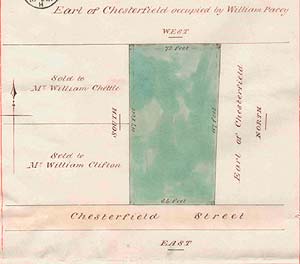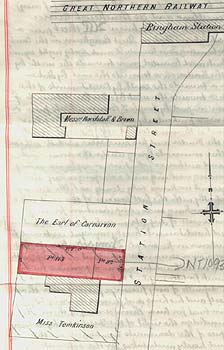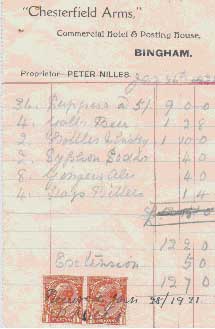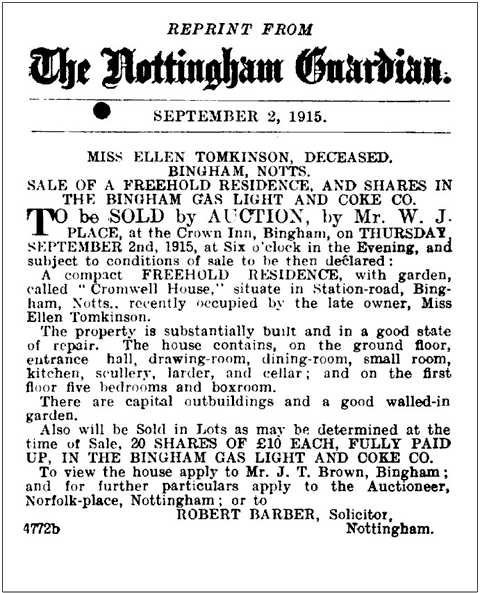![]()
Cromwell House
3 Station Street
Summary
 Cromwell House is built on a plot that once
was part of the land attached to Beauvale House, to the west, and
owned by the Earl of Chesterfield. The Abstract of title of 1879
recites in great detail the various trusts associated with the estate.
In 1857 the plot was separated from the rest of the farmland attached
to Beauvale House and sold for £214.10s to William Huckerby,
gentleman of Bingham for him to build a house, which had to cost
at least £300. Huckerby was a legal man, engaged as Clerk
to Guardians, asst clerk County Court, Superintendent Registrar
and of the Secretary Gas Works. Prior to these employments he was
an auctioneer. His office premises were in Market Street. About
the same time two similar plots, to the south of Cromwell House
were sold to Samuel Chettle and William Clifton respectively, so
all three houses date from around the same period.
Cromwell House is built on a plot that once
was part of the land attached to Beauvale House, to the west, and
owned by the Earl of Chesterfield. The Abstract of title of 1879
recites in great detail the various trusts associated with the estate.
In 1857 the plot was separated from the rest of the farmland attached
to Beauvale House and sold for £214.10s to William Huckerby,
gentleman of Bingham for him to build a house, which had to cost
at least £300. Huckerby was a legal man, engaged as Clerk
to Guardians, asst clerk County Court, Superintendent Registrar
and of the Secretary Gas Works. Prior to these employments he was
an auctioneer. His office premises were in Market Street. About
the same time two similar plots, to the south of Cromwell House
were sold to Samuel Chettle and William Clifton respectively, so
all three houses date from around the same period.
Huckerby died in 1878 and the executors sold the house for £750 to Miss Ellen Huckerby. She may have been William's sister (still to research) and ran a grocery shop in Market Street. She sold 6 months later to Charles Richard Thompson Doncaster, a farmer from Farnsfield, for £850. Doncaster was probably a member of the long established Bingham family with several business interests in the town.
Charles Doncaster died in 1897 leaving Cromwell House to his cousin and housekeeper Elizabeth Sarah Morris. Less than a year later, on 6 September 1898, Sarah sold the house to Miss Ellen Tomkinson, spinster of Chilwell Road, Beeston for £975.
She died on 25th June 1915 and the house was sold at public auction at the Crown Inn to Robert Francis Brown of Porchester Terrace, of Bingham, a lace manufacturer. In 1920 he bought the strip of land for the drive on the north side from the Earl of Carnarvon for £70, part of the extensive sale of freeholds in 1920. He remained here until his death in 1937 and was succeeded in the house by his son, also Robert Francis.
The present owners purchased Cromwell House in 1980 and developed the dental practice premises in 1993. During restoration they have found a number of interesting papers that are described in the annex to this note.
Review of the deed papers, trade directories and census returns
The first deed document is an abstract of title drawn up in 1879 of the eighth Earl of Chesterfield drawn up prior to the first sale of this piece of land from the Shelford Estate. The abstract recites the will of the fourth Earl, Philip Dormer Stanhope wherein he bequeathed his estate to his godson Philip Stanhope, who also inherited the title as fifth Earl.
Philip Dormer was a prominent man (see extract from Microsoft® Encarta® Online Encyclopaedia 2001 in 1 Market Place). He died in 1773 and in his will left 'all his manors messuages lands tenements and hereditaments in Buckinghamshire, Bedfordshire, Hertfordshire, Derbyshire and Nottinghamshire' in trust naming Lovel Stanhope and Beaumont Hotham as trustees.
However he did look after his widow, Lady Stanhope leaving her an annuity of £1000 per year 'issuing out of the estates of estates that were his late brother's'. The latter is presumably Sir William (died 1772) and or John Stanhope, Lord of the Admiralty (died in 1704), both without marrying. Or Lady Stanhope might have been his sister Gertrude who also outlived him and died in 1775 without marrying. It might be more logical to cite his brother's estates, which he would have inherited, to support his sister.
His wife, Petronilla was Baroness Aldborough, an illegitimate daughter of King George I, and may well have been provided for by the Royal Household. She died in 1778. It is perhaps no great surprise that they did not have children; at the time of their marriage he was 39 and she was 40.
Various other arrangements, generally 'to the use of … for their life' were made for many of the Stanhope clan and their heirs and successors. Several servants and others did quite well too. He also left an annuity of £100 to Charles Stanhope, son of this Philip. The settlements were described as 'to preserve continuing remainders', which presumably is legal speak for ensuring the continuity and integrity of the estate whilst enabling various descendents have the use and income of various bits during their lives.
His valet received an annuity of £80 and his valet's son £20 pa. William Stanhope, son of his late brother, Sir William, who died in May 1772 (a month before Philip Dormer's will), received an annuity of £100 and Mrs Ilsey an annuity of £35 'in lieu and discharge of like annuities given them in his brother's will'.
Philip Dormer's (illegitimate) son, Philip Stanhope, had predeceased him so he had no direct heir. He bequeathed the residue of his estate to his godson, also Philip Stanhope, the son of 'his kinsman' Arthur Stanhope. The godson is described in encyclopaedia articles as a distant cousin. He inherited the title following the normal rules of lineage (not because he happened to be Philip Dormer's godson and chosen heir, as some writers imply) and became 5th Earl. He was a distant cousin in that his line does not connect with the 4th Earl's until the lines reach back to the first Earl (another Philip), who died in 1656.
Philip thus became the 5th Earl in 1773 and died in 1815. The deeds are silent in respect of him. The next event in the abstract is an indenture of Lease and Release by George Stanhope, 6th Earl, Philip's son.
The indenture, of lease and release, dated 3rd and 4th November 1826 is between the Earl and Henry Archer Raymond and George Law, both of Lincolns Inn. Lease and Release was a device for transferring freeholds outside the family without having to register the transaction and reveal names. But in 1827 (dated in the abstract as 7 Geo 4th) there is an 'Exemplification of common recovery', wherein the whole lot is transferred back to the earl. (An exemplification is an attested copy of a document). This whole process seems to be a method of setting up a new trust, maybe none too publicly, for the future protection of the estate.
The Abstract in the Cromwell House deeds of the 1826 indenture specifically itemises: 'all that messuage or tenement with barns stables farm lands and hereditaments thereto belonging or occupied therewith situate and being in the parish of Bingham containing 176 acres 2 roods and 11 perches and then or late in the tenure or occupation of William Pacey, his undertenants or assigns'. From the plan below this is clearly Beauvale House, from which land the plots for Cromwell House, The Limes and Vernon House have clearly been detached.
White's directories between 1832 and 1864 show Pacey as a farmer of Market Place, so the two sets of information help with the story of Beauvale House too.
On 20 and 21 October 1830 new indentures were drawn up, but in respect of properties in Derbyshire and Nottinghamshire only, between George Stanhope, 6th earl and Rt Hon Ann Elizabeth Forrester, daughter of Lord Forrester, in anticipation of their forthcoming marriage. Three pairs of new trustees seem to have been appointed -Arthur Stanhope and Rev Charles Williams (Rector of Cubley, 6 miles south of Ashbourne); the Duke of Rutland and John Weld Forrester; Viscount Castlereagh and Rt Hon Henry Cavendish.
The abstract has 14 pages of provisions covering just about every possibility for the succession and how various current and future members of the family shall be treated. [The abstract of the same indenture in the deeds of 1 Market Place took 6 pages to summarise the same indenture and also has some interesting additional information about Philip Dormer's will.] A trust was set up whereby Elizabeth was to be paid £800 per annum during their joint lives 'for her personal use and not to be subject to debts contracts engagements or control of the Earl, her intended husband…'. It provided for an annuity of £4000, payable from the rents of the estate, for Elizabeth should she survive him. The indenture dealt in some detail with inheritances (£10000 each) at age 21 for any future sons or daughters at age 21 or on marriage if earlier and allowances for children up to and after age 12. It also provided that money should be used for the education and professional training of younger sons - the eldest would inherit so was assured of a job.
It made similar provisions for any future wife or wives should Ann pre-decease him. The indenture gave the Trustees power to sell any parts of the estate at the Earl's request except the family seat at Bradby (Bretby) Park.
On 8 May 1857 The 6th Earl sold to William Huckerby,
gentleman of Bingham, 'all that piece of land measuring in length E-W
117 feet and breadth at the west end 72 feet and East 64 feet and containing
in 884 square yards. The price was £214.10.0d
The land was bounded on:
| North |
by land of the Earl of Chesterfield |
| South |
by property late of the earl but then of Mssrs Clifton and Chettle (this helps us date the two houses (once Vernon House and the Limes) making up 18 Market Place. The Limes is seemingly of exactly the same design, even to internal fittings such as banisters) as Cromwell House. |
| East
|
by Chesterfield Street |
| West |
by land belonging to the Earl and in the occupation of William Pacey - i.e. Beauvale House. This also helps date Beauvale, as Pacey appears in directories as far back as 1832. |
Huckerby was to erect a 5 feet high fence and no dwelling house was to built of less value than £300, so the Earl clearly wanted something decent. He had imposed similar conditions on the cost of other houses (e.g. 9 Newgate Street) we have come across. He was also not to erect, build, use or work any steam engine or mill, manufactory or nay other buildings for making or manufacturing glue, starch, grinding of bones, melting of tallow, making of candles, slaughter of cattle or carry on any noisome noxious or offensive trade or business or manufactory of blacksmith, whitesmith, coppersmith, brazier or dyer. So the neighbourhood was intended to salubrious, although by the 1880s a steam corn mill and a timber yard had arrived at the end of the street.
Huckerby seems to have been an important man in Bingham. However there are a lot of William Huckerbys in the various directories and it is difficult to work out relationships. It is tempting to suppose the three boxes represent three generations of grandfather, father and son, but the simultaneous occupations of auctioneer and grocer for William Huckerby senior seem a bit unlikely. A second directory has only Huckerby junior as auctioneer with no mention of senior. When time permits we shall be looking at census information for a number of the houses for which we have examined deeds. We shall also check a few more directory entries.
Directory Entries so far recorded:
| 1793 |
William Huckerby | Tailor and Mercer | No address |
| 1822 |
William Huckerby | Linen Draper | Market Place |
| 1844 |
Wm Huckerby | snr Shopkeeper | Market Place |
| 1853 |
Wm Huckerby | Shopkeeper | Market Street |
| 1855 |
Wm Huckerby | Grocer | No address |
| 1864 |
Wm Huckerby | Grocer and Tea Dealer | Market Street |
| 1877 |
Misses Elizabeth and Ellen Huckerby | Grocers | Market Street |
| 1832 |
Wm Huckerby | snr & jnr Auctioneers | Market Place |
| 1844 |
Wm Huckerby | jnr Clerk to Union and Magistrates. Superintendent Registrar | Market Place |
| 1853 |
Wm Huckerby | jnr Clerk to Union, and Magistrates, asst clerk County Court, Superintendent Registrar | Market Street |
| 1855 |
Wm Huckerby | jnr Clerk to Guardians, asst clerk County Court, Superintendent Registrar, Secretary Gas Works | No address |
| 1864 |
Wm Huckerby | Clerk to Guardians, asst clerk County Court, Superintendent Registrar, Secretary Gas Works | Market Place (residence Station Street) |
| 1877 |
Wm Huckerby | No profession | Station Street |
| 1879 |
Wm Huckerby | Superintendent Registrar | Station Street |
William Huckerby died in 1878 aged about 68 (he had been 61 at the 1871 census) and in his will appointed James Shimeld, bookseller and stationer and George Brown, grocer, both of Bingham as executors with instructions to sell and dispose of his estate in parcels by public auction or private contract. Possibly Huckerby had more property and no direct descendent to whom to leave his estate. Shimeld was assistant registrar, presumably worked with Huckerby. In 1879 George Brown was a partner with Mrs Sarah Hardstaff in the well-known grocer shop Hardstaff and Brown, and at some later point this company ran the steam mills in Station Street. In 1877 he was listed as living in Needham Street.
On 11 October 1878 the executors sold the house for £750 to Miss Ellen Huckerby, presumably one of the sisters who are recorded as grocers in Market Street in the directory of 1877. It would be interesting to establish her relationship with William, and one wonders if they were related (possibly brother and sister) why the property or a part of it did not pass to her in the first place.
In the 1881 census she is listed as a lodger of Frederick Hemstock, baker, butcher and grocer. She was an annuitant and aged 65. The only Elizabeth Huckerby listed in that census is aged 46 and is the wife of a joiner, John, living in the Market Place. Clearly unlikely to be the grocer's sister.
Ellen seemed to have no intention of living in it as she sold to Charles Richard Thompson Doncaster on 7 May 1879 for £850. A curious paragraph in the indentures for sale to Ellen and to Doncaster describe the land on the west as being owned by the Earl of Carnarvon and late in the occupation of W Huckerby decd and now of Ellen Huckerby or her tenant. Was this the whole of the Beauvale House property or had they rented a patch for some purpose? Pacey is not in the directory of 1877, so something must have happened.
Doncaster was a farmer of Farnsfield and curiously his indenture of sale declares that his widow (if any) shall not be entitled to dower. In the 1881 census he is shown as a retired farmer aged 55 and unmarried. His cousin is resident as his housekeeper.
Doncasters were a large Bingham family with many interests, including the drapers and grocery on the corner of Church Street (now the estate agent), building, surveying, grocery shop etc. In 1881 Henry Doncaster aged 73 was described as an accountant and lived in Market Place - probably in the Manor House. In the directory of 1864 he was described as Assistant Overseer, assessor and collector of taxes and secretary to the Gas Company. In 1879 he was deputy registrar of births marriages and deaths and house agent in addition to the other jobs!
Charles Doncaster died in 1897 leaving his real estate and residue of personal estate to his cousin and housekeeper Elizabeth Sarah Morris. Less than a year later, on 6 September 1898, Sarah sold the house to Miss Ellen Tomkinson, spinster, of Chilwell Road, Beeston for £975. The Beauvale House land on the western boundary was still owned by the Earl of Carnarvon. In Kelly's 1908 directory she is listed as a private resident of Cromwell House.
She died on 25th June 1915 having appointed James Thomas Brown, ironmonger, of Bingham as an executor with instructions to sell the residue of her estate after certain legacies. The advertisement below shows this to have been done by public auction at the Crown Inn, and that she was also a shareholder in the gas company. Following the auction the house was sold to Robert Francis Brown of Porchester Terrace (the Victorian semi detached villas on Long Acre, near Porchester Farm), a lace manufacturer. James Thomas Brown is described in the conveyance as gentleman and in the 1922 directory is shown as living in Beauvale House. A George Brown was at the Limes. One wonders if they were all related.
 On 5 February 1920 Brown purchased
a strip of land from the Earl of Carnarvon for £70
to form the driveway and on which to build the garage.
Several deeds we have seen show the Earl selling freeholds
in 1920, and one wonders if this was to raise cash for
his excavations in Egypt, where in 1923 with Howard Carter
he discovered the tomb of Tutankhamen. Interestingly,
the plan shows the plot now occupied by ''Northleigh'
as being owned by Carnarvon and without a house on it.
It has always been assumed that Northleigh dates from
about 1910 - so is the plan an old one or is the house
just missing or what? And did Carnarvon perhaps sell the
freehold here in 1920 as well? A plan (clearly a rough
tracing of this one) attached to a Land Tax redemption
certificate of 1921 shows Northleigh land (still no house)
as being owned by Wilkinson. We would welcome the chance
to see the deeds! Beauvale is still shown as owned by
Lord Carnarvon (so might the same 1920 rule apply here?)
and occupied by Joseph T Brown. The Earl's abstract of
title recites the manner in which the Chesterfield estates
came to him through his father's marriage with Evelyn,
sister of the seventh Earl of Chesterfield.
On 5 February 1920 Brown purchased
a strip of land from the Earl of Carnarvon for £70
to form the driveway and on which to build the garage.
Several deeds we have seen show the Earl selling freeholds
in 1920, and one wonders if this was to raise cash for
his excavations in Egypt, where in 1923 with Howard Carter
he discovered the tomb of Tutankhamen. Interestingly,
the plan shows the plot now occupied by ''Northleigh'
as being owned by Carnarvon and without a house on it.
It has always been assumed that Northleigh dates from
about 1910 - so is the plan an old one or is the house
just missing or what? And did Carnarvon perhaps sell the
freehold here in 1920 as well? A plan (clearly a rough
tracing of this one) attached to a Land Tax redemption
certificate of 1921 shows Northleigh land (still no house)
as being owned by Wilkinson. We would welcome the chance
to see the deeds! Beauvale is still shown as owned by
Lord Carnarvon (so might the same 1920 rule apply here?)
and occupied by Joseph T Brown. The Earl's abstract of
title recites the manner in which the Chesterfield estates
came to him through his father's marriage with Evelyn,
sister of the seventh Earl of Chesterfield.
Evelyn had inherited £20000 from the sixth Earl and after the death without issue of her brother the estates passed in trust to her. She confirmed the terms of her father's will in that the use for life of the estates passed to the eighth and ninth Earls (distant cousins) and on their deaths the estates reverted to her. Her son, the fifth earl of Carnarvon, inherited from her. She also confirmed the annuity of £4000 pa for her mother the dowager Countess of Chesterfield. Mortgaging the estates with trustees raised all of the cash sums. All this paperwork for a driveway!
The final paper in the deeds bundle is an Assent by Robert Francis Brown of Cromwell House as the sole surviving executor of his father Robert Francis Brown late of Cromwell house to the property being vested in him.
The house was owned briefly by a local small builder and purchased by the present occupants in 1980. The dental practice premises were developed over the garage in December 1993.
Other documents
Land Tax Assessment of 12 October 1857 in the name of Huckerby for one shilling for:
'A messuage or tenement with outbuildings garden and appurtenances thereunto adjoining and belonging situate and being in Station Street in Bingham lately belonging to John Braithwaite and now in possession of William Huckerby and comprising the site of the aforesaid messuage and buildings of eight hundred and fifty square yards or thereabouts'
So who was John Braithwaite? I have not come across him in directories yet. The conveyance from the Earl of Chesterfield to Huckerby does not mention him, which it would if he was in occupation at the time, say as a tenant. Did he build the house and for some reason counted as owner/occupier at the time of assessment? The information was supplied on the Redemption application form, which is with the papers and signed by John Doncaster acting as Huckerby's agent. Doncaster was a surveyor whose name appears on several of the deeds we have examined.
Tax Assessment of 21 January 1921 in the name of Brown in respect of the strip of land bought from the earl of Carnarvon and in the sum of 3d. Redemption was calculated at 30 times tax, so he paid 7s 6d. The property was thereafter exonerated from land Tax.
Tithe Duty Redemption papers from 1921. Again this looks like a means of buying oneself out of tithes by paying a lump sum, in this case £193.9.8d. This included 'other lands' than just the Cromwell House land. The tithe plan (1840) numbers are just about recognisable on the copy of the tithe plan held by Notts Archive Office. 35 was the westernmost portion of the Beauvale land. There is a receipt signed on 22 August 1921 by Canon Hutt, of Bingham Rectory, for £1.6.9d in respect of 19 years purchase (at 1/4d pa) of tithe redemption specifically relating to the Cromwell House land.
The present owners have found a number of billheads from local suppliers from the year 1921. One is from the Chesterfield Arms in respect of a choir supper there, costing £12.7.0d. Robert Brown was church organist and choir master. Another is from Hitchcock's jewellers of 1 Market Place for one dozen teaspoons at 12/6d.


